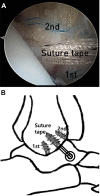Suture Tape Augmentation in Lateral Ankle Ligament Surgery: Current Concepts Review
- PMID: 35097476
- PMCID: PMC8532228
- DOI: 10.1177/24730114211045978
Suture Tape Augmentation in Lateral Ankle Ligament Surgery: Current Concepts Review
Abstract
Chronic lateral ankle instability (CLAI) is a condition that is characterized by persistent disability and recurrent ankle sprains while encompassing both functional and mechanical (laxity) instability. Failure of conservative treatment for CLAI often necessitates operative intervention to restore the stability of the ankle joint. The traditional or modified Broström techniques have been the gold standard operative approaches to address CLAI with satisfactory results; however, patients with generalized ligament laxity (GLL), prior unsuccessful repair, high body mass index, or high-demand athletes may experience suboptimal outcomes. Synthetic ligament constructs have been tested as an adjunct to orthopedic procedures to reinforce repaired or reconstructed ligaments or tendons with the hope of early mobilization, faster rehabilitation, and long-term prevention of instability. Suture tape augmentation is useful to address CLAI. Multiple operative techniques have been described. Because of the heterogeneity among the reported techniques and variability in postoperative rehabilitation protocols, it is difficult to evaluate whether the use of suture tape augmentation provides true clinical benefit in patients with CLAI. This review aims to provide a comprehensive outline of all the current techniques using suture tape augmentation for treatment of CLAI as well as present recent research aimed at guiding evidence-based protocols.
Keywords: Brostrom repair; instability; lateral ankle; outcomes; suture augmentation.
© The Author(s) 2021.
Conflict of interest statement
Declaration of Conflicting Interests: The author(s) declared the following potential conflicts of interest with respect to the research, authorship, and/or publication of this article: Eric W. Tan, MD, reports personal fees from Arthrex Inc outside the submitted work. ICMJE forms for all authors are available online.
Figures



References
-
- Acevedo J, Vora A. Anatomical reconstruction of the spring ligament complex: “internal brace” augmentation. Foot Ankle Spec. 2013;6(6):441–445. - PubMed
-
- Acevedo JI, Palmer RC, Mangone PG. Arthroscopic treatment of ankle instability: Brostrom. Foot Ankle Clin. 2018;23(4):555–570. - PubMed
-
- Aicale R, Maffulli N. Chronic lateral ankle instability: topical review. Foot Ankle Int. 2020;41(12):1571–1581. - PubMed
-
- Bejarano-Pineda L, Amendola A. Foot and ankle surgery: common problems and solutions. Clin Sports Med. 2018;37(2):331–350. - PubMed
Publication types
LinkOut - more resources
Full Text Sources
Medical
